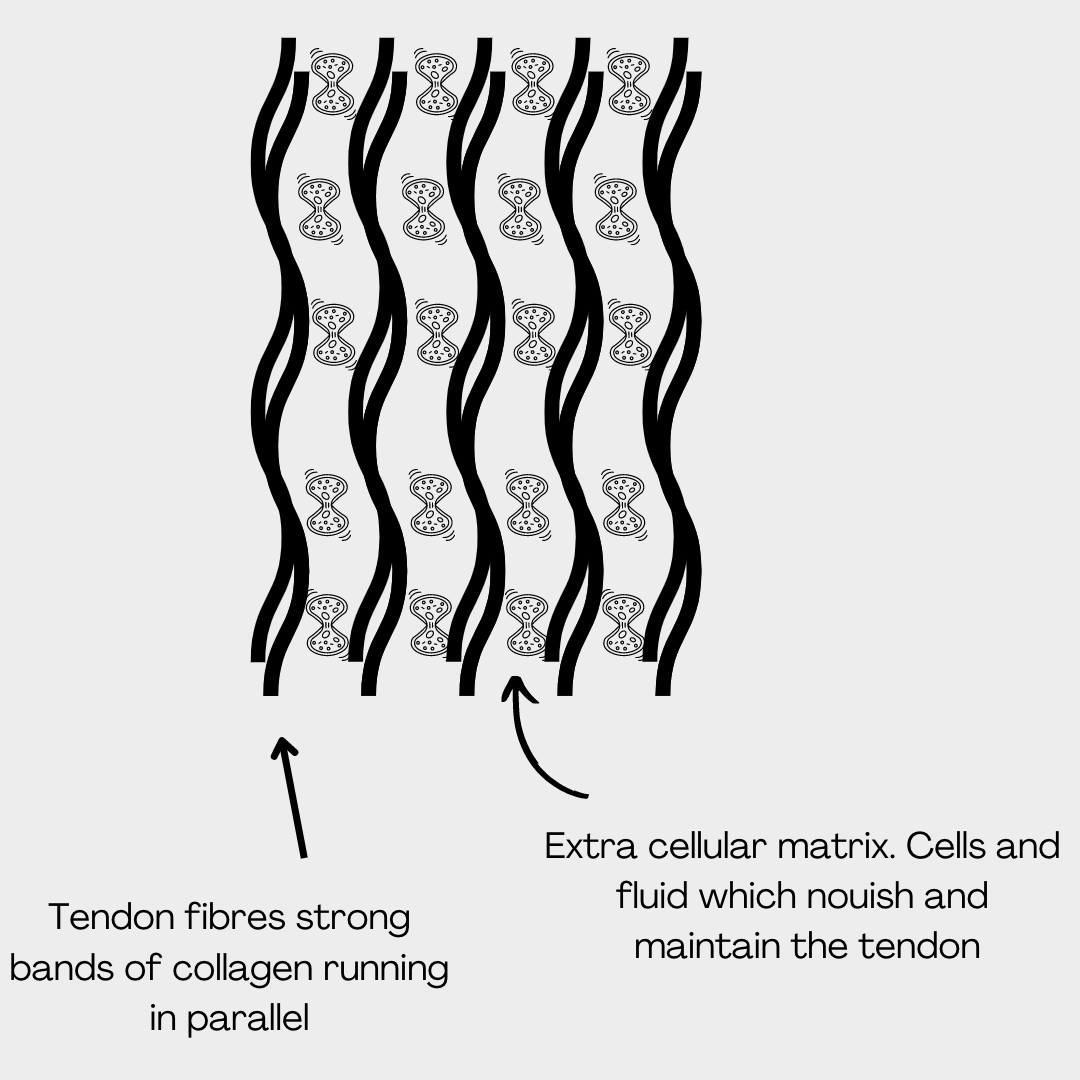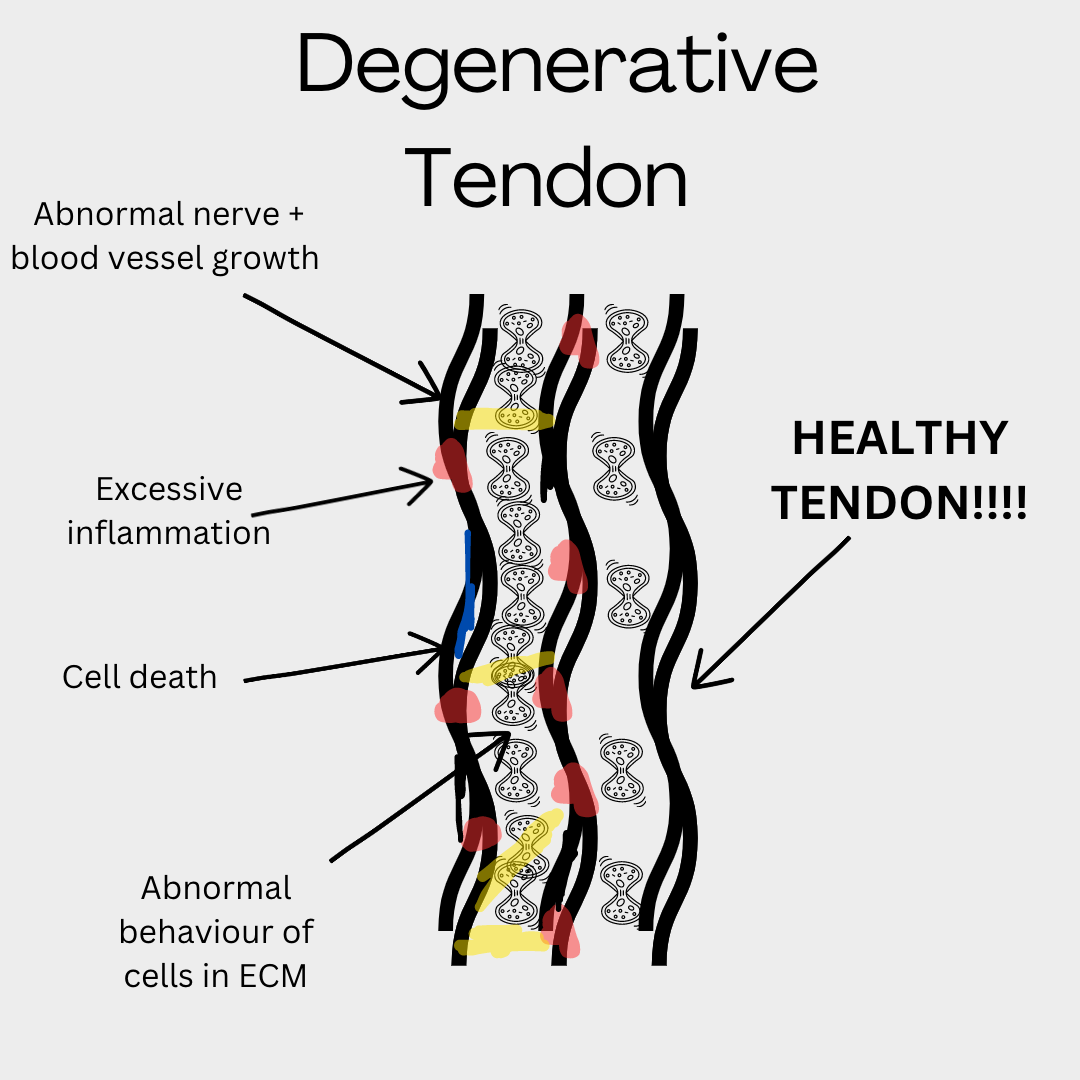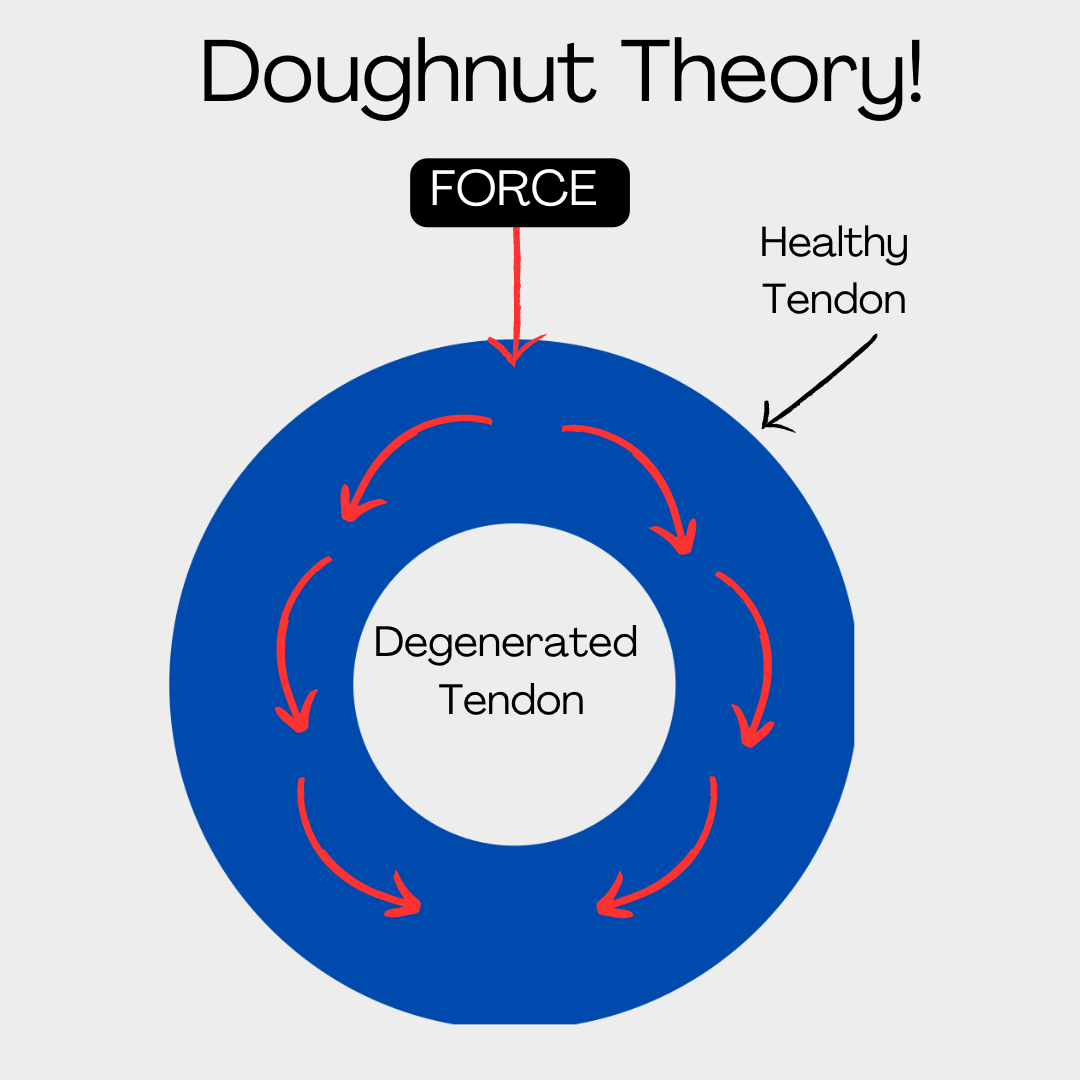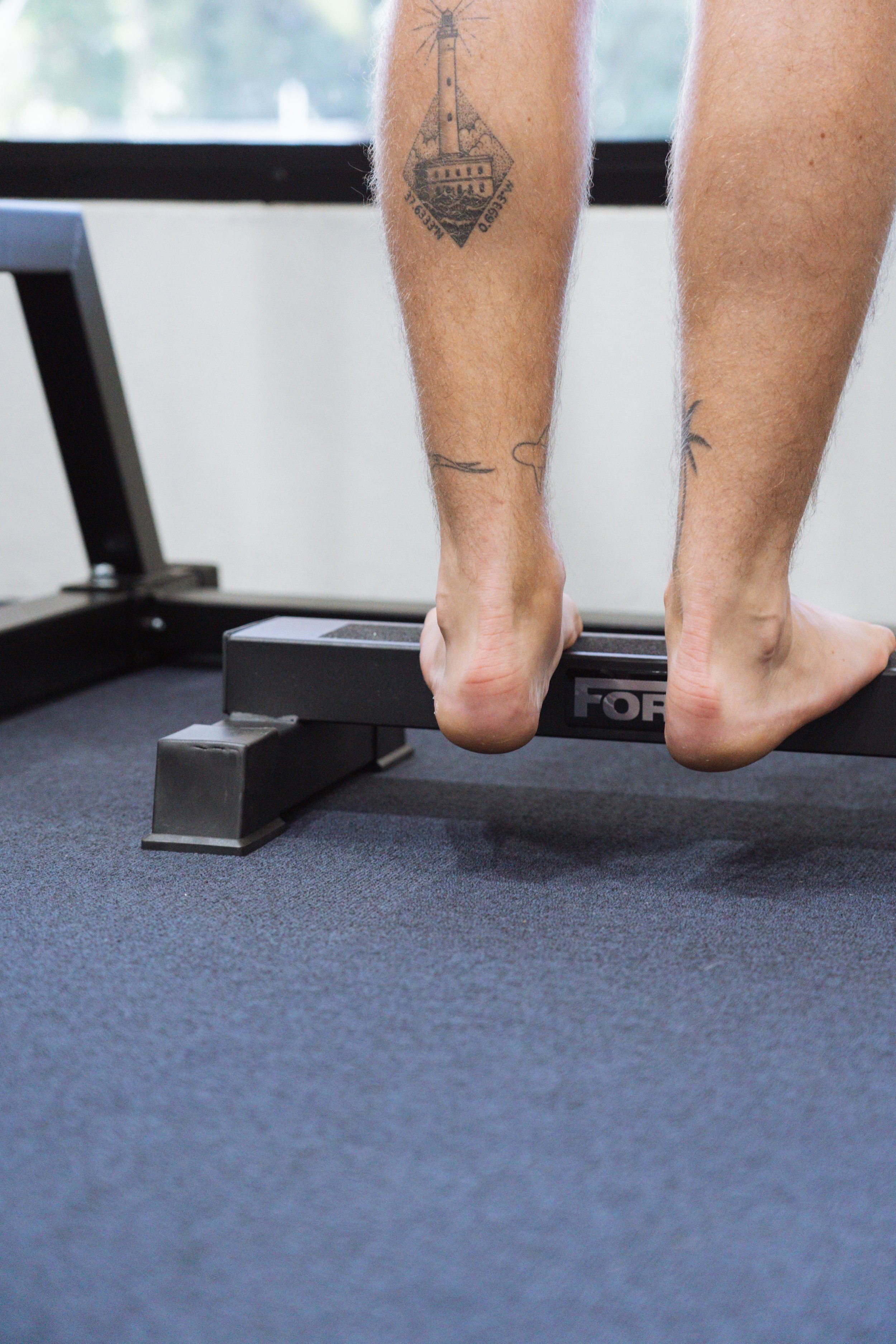What is a Tendinopathy?
A tendinopathy is a reactive or degenerative process affecting a tendon.
A tendon is a connection between muscles and bone, we have around 4000 tendons within the human body which assist us in a variety of different ways.
1) Provide passive joint stability along with other connective tissues such as ligaments
2) Providing a muscle with an anchor point at one end, and an insertion point at the other. The connection formed allows the muscle to contract (shorten), pulling on the insertion point to produce movement about a joint.
3) Provide absorption of energy. In the case of tendons such as the achilles and patella, this energy is stored momentarily and then transmitted back as elastic energy. This mechanism increase the efficiency of movements such as walking, running, jumping an hopping.
Healthy Tendons
Tendons are comprised of the fibres which transmit load, and the supporting fluid and cells termed the extra cellular matrix.
Once our bodies reach maturity, healthy tendon fibres don’t significantly change in their makeup. It is the job of the cells and fluid of the extra cellular matrix to maintain the health of the tendon fibres and protect them against the stresses of everyday life (this process is termed homeostasis)
Whilst tendons can adapt to changes in their everyday stress (be that increases or decreases), they do so slowly.
Whilst structures such as muscles can adapt rapidly (in weeks or months), tendons generally take months to years to undergo significant adaptive changes.
This makes them susceptible to injury when there are rapid changes in the stress levels they are put under.
Reactive Changes
Individual tendon fibres can start to undergo stress induced changes if exposed to a significant increase in stress levels over a short period of time. We term these stress induced changes a “reactive” tendinopathy
As a generally healthy tendon has a limited number of pain recepting nerves these changes may or may not induce a pain response. If you are reading this it is likely that you have had a reactive tendinopathy in the past and not even known about it!
Within this reactive stage if overall loads are adequately reduced and the tendon placed into the correct environment then there is potential that the affected fibres can regenerate and return to their normal state
Degenerative Changes
If a tendon is in a reactive state for a sustained period of time, the changes that are occurring with the fibres start to become more permanent in nature.
A number of factors can contribute towards a reactive tendinopathy progressing to a degenerative tendinopathy. These factors include excessive loads over sustained periods of time, too little load over a sustained period of time, genetics, age, weight, diabetes, smoking, rapid changes in activity levels and poor movement patterns.
Whilst we don’t entirely understand why tendons become painful it has been observed that as tendons become more severely degenerated abnormal blood vessel and sensory nerve growth starts to occur.
Increased nerve growth can lead to an increased number of pain receptors. Whilst increased blood vessels can lead to excessive inflammation and a high number of chemicals in the extra cellular matrix that can induce pain.
These processes may be why a tendon can seemingly start to become painful for no reason at all!
It is important to note that this degenerative process does not occur in the entire tendon. In fact, you can have individual tendon fibres that are highly degenerated, right next to completely healthy ones!
Doughnut Theory
We used to think that we could stimulate tendons to heal through physiotherapy treatments such as tendon specific exercise, dry needling and shockwave. However, more recent research indicates that once a tendon fibre is degenerative significant repair is very unlikely.
It is thought that a degenerative tendon fibre is no longer able to transmit load. Fortunately, the healthy tendon fibres are able to take up the slack, and transmit load around the degenerative fibres. We term this the doughnut theory!
Unfortunately as these tendon fibres are having to do more work, they are susceptible to tendinopathy themselves. This point will be important in a few paragraphs time.
The Role of Physiotherapy
Our first aim remains the same…. TO GET YOU OUT OF PAIN.
Whilst the reasons for pain from the tendon itself remains unclea,r a person with a tendinopathy may actually have other structures which are causing them pain at the same time. In fact in some cases the tendon itself may not actually be the painful structure at all!
We used to treat all tendons the same way. However, we are now starting to notice that tendons all require different treatments and that certain tendinopathies may have certain structures which are contributing towards pain.
For example in the case of tennis elbow, (affecting the tendon on the outside of the elbow) pain could be coming from the tendon itself, the elbow muscles, the shoulder, the neck, the upper back or the radial nerve (branching out of the neck and running down into the outside of the arm).
As physiotherapist, we have many different ways to reduce the pain you may be experiencing. This would depend upon your presentation, the tendon that is affected and the other structures which may be contributing towards the symptoms you are feeling.
Physiotherapy DOES NOT stop once the pain starts to reduce!
Once pain is under control, our aim switches towards preventing pain reoccurrence, preventing further degeneration and increasing your ability to continue with your normal activities.
Some of this may come from looking at your work environment, the hobbies and sports you do, the way you move and the muscles and joints around the affected tendon
More recently we have started to look at the affected tendon too…..
Whilst the degenerated fibres have no capacity for healing, the healthy fibres retain capacity to adapt, becoming stiffer (a good thing) and increasing their ability and tolerance to transmit load.
As mentioned above, normally tendon adaptations take long periods of time.
However, the latest research studies have suggested that specific types of exercise that focus upon the tendon itself, can be used to speed this process up dramatically. Significant changes in tendon make up have been seen in as little as 12 weeks!
With doughnut theory in mind, it would make sense that we make the remaining health tendon as robust as we can!
A comprehensive approach to tendinopathy is a must for you to reach your full potential and to reduce the chances of further pain or injury. Tendon rehabilitation is so so much more than a massage and some elastic band exercises,
If you have a tendon injury do not get hesitate to get in contact with us today!





